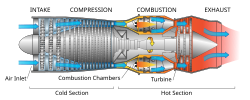Engine
An engine, or motor, is a machine used to change energy into movement that can be used.[1] The energy can be in any form. Common forms of energy used in engines are chemical energy (such as petrol or diesel), or heat. When a chemical is used to produce energy it is known as fuel.
Terminology
In past centuries motor and "engine" meant very different things.[2] A motor was made to move something such as a vehicle. This meaning is still often used. Sometimes a thing is called an engine if it creates mechanical energy from heat, and a motor if it creates mechanical energy from other kinds of energy, like electricity. Typical engines in this meaning are steam engine and internal combustion engine, while typical motors are electric motor and hydraulic motor. And sometimes the two words mean the same thing.
"Engine" was originally a term for any machine that converts force into motion. Hence, pre-industrial weapons such as catapults, trebuchets and battering rams were called "siege engines". The word "gin," as in "cotton gin", is short for "engine." The word derives from Old French engine, from the Latin ingenium, which is also the root of the word ingenious. Most mechanical devices invented during the industrial revolution were described as engines—the steam engine being a notable example.
Piston engines
Early kinds of engine used heat that was outside of the engine itself to heat up a gas to a high pressure. This was usually steam and the engines are called steam engines. The steam was piped to the engine where it pushed on pistons to bring about motion. These engines were commonly used in old factories, boats and trains.
Most cars use a chemical engine that burns fuel inside it. This is called an internal combustion engine. There are many different types of internal combustion engine. They can be grouped by fuel, cycle and configuration. Common fuel types for internal combustion engines are petrol, diesel, auto gas and alcohol. There are many other types of fuels.
There are 3 different types of cycle. 2-stroke engines produce power once every turn of the engine. 4-stroke engines cylinders make power once every two turns of the engine. 6-stroke engines cylinders make power twice in every six turns of the engine.
There are lots of different configurations of piston engines. Their cylinders have pistons in them and a crankshaft. Any number of cylinders can be used but 1, 2, 3, 4, 6, 8, 10 and 12 are common. The cylinders can be arranged in many ways, in a straight line, at an angle to each other or in a circle.
A Wankel engine has no cylinders and uses a triangle shaped rotor spinning in an oval housing which mimics the movement of a piston.
Turbine engines
Hot gas can also be made to push a turbine around rather like the way the wind turns a windmill. Most electric power stations use big steam turbines. Others use water or wind turbines. Smaller turbines called gas turbines are used for internal combustion engines, such as the jet engines used in aircraft.
Rocket engines
A rocket causes movement by shooting jets of gas very fast out of a nozzle. The gas may have been stored under pressure or be a chemical fuel that burns to make a very hot gas. Although they are very simple, rockets are the most powerful engines we know how to make. They will work in space where there is nothing to push against.
Electric motors
Electric motors do not use a fuel. The energy is supplied to them by electricity carried along wires. The energy may come from a fuel being burnt somewhere else a long way off. The electricity is used to make powerful magnets inside the motor switch on and off at the right time to turn the shaft of the motor.
Electric engine is not a motor, but a railway locomotive which runs on electricity.
Engine Media
- An animation showing the four stages of the four-stroke gasoline-fueled internal combustion cycle with electrical ignition source:
- Induction (Fuel enters)
- Compression
- Ignition (Fuel is burnt)
- Emission (Exhaust out)
Jet engines use the heat of combustion to generate a high-velocity exhaust as a form of reaction engine. Mechanical energy to power the aircraft's electrical and hydraulic systems can be taken from the turbine shaft, but thrust is produced by expelled exhaust gas.
A V6 internal combustion engine from a Mercedes-Benz
Related pages
| Wikimedia Commons has media related to Lua error in Module:Commons_link at line 62: attempt to index field 'wikibase' (a nil value).. |
Reference section
- ↑ "Engine - Energy Education". energyeducation.ca. Retrieved 2024-06-10.
- ↑ "MIT School of Engineering | » What's the difference between a motor and an engine?". Mit Engineering. Retrieved 2019-12-16.









